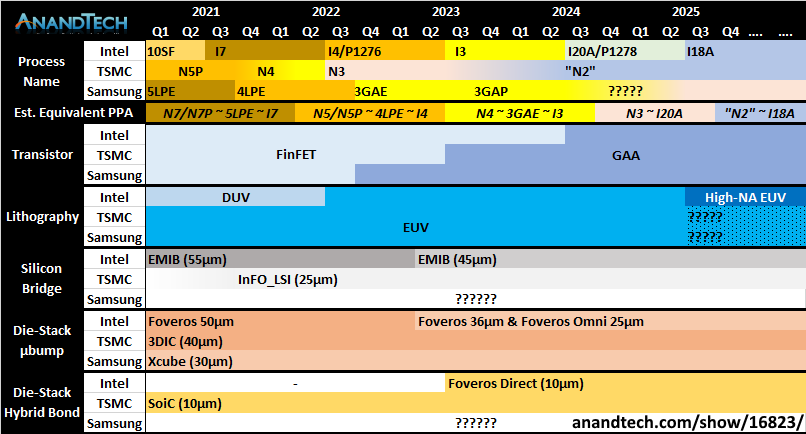Intel's Process Roadmap to 2025: with 4nm, 3nm, 20A and 18A?!
by Dr. Ian Cutress on July 26, 2021 5:00 PM ESTCustomers Customers Customers
As a roadmap announcement today, the focus isn’t so much on the customers but on the technology. Because Intel is moving into a phase where it expects its IFS offerings to compete against the established players, it has to consider its disclosures with respect to both its internal use and any external interest, which is a new concept for the company – at least on this scale compared to its previous foundry efforts.
Intel CEO Pat Gelsinger, in the company’s Q3 financial call last week, was keen to point out that they already have a large hyperscaler customer signed up for their next generation packaging technology, however today there would appear to also be another customer in the mix. Now we assume that Intel’s Foundry Services is talking to 100s of chip companies, big and small, but it doesn’t take much to sign an NDA to start to talk – what will be interesting is when customers start making commitments to using Intel’s facilities, and if any of those are volume orders.
As part of the announcement today, Intel held a little bit back from us, saying that they are saving some of the details specifically for the event that is going on as we publish this piece. All we know is that our draft press release has a big yellow bar that says ‘[customer news]’ on it, right next to Intel’s 20A process node details.
For reference, Intel 20A is a 2024 technology using first generation Gate-All-Around transistors, marketed as RibbonFETs, as well as backside power delivery, marketed as PowerVias. At this time Intel expects to have second/third-generation EMIB available as well as fourth-generation Foveros Direct. So if a customer is already committing to Intel 20A, there’s going to be a lot of potential here.
When the announcement is made, we will update this news article.
To conclude, Intel maintains that these roadmaps will showcase a clear path to process performance leadership* by 2025. It’s a tall order, and the company has to execute better than it has in recent memory - but that’s kind of why the company has rehired a number of former Intel experts and fellows in research, product design, and execution.
*as measured by performance per watt at iso-power
Here's a secondary comparison chart (compared to the one on page one) with all three main foundry offerings listed in each of the main segments that Intel has discussed today.











326 Comments
View All Comments
DigitalFreak - Monday, July 26, 2021 - link
It is 20 amps. That's how many amps @ 110v you'll need in the near future to power just their processor.mode_13h - Monday, July 26, 2021 - link
Lol. Pretty much.Timoo - Tuesday, July 27, 2021 - link
Although 20A sounds reasonable for an Intel, these days /sboeush - Monday, July 26, 2021 - link
Instead of this meaningless "nm" node name stupidity, Intel should've just moved to a transistor-density-based node naming. For example, "Intel 100" for 100 million transistors per square mm. Then for same-node refinement (where density stays the same but transistor or circuit performance improves), they could've used a revision number - e.g. Intel 100 mk. 1, Intel 100 mk. 2, etc.That would've returned industry nomenclature back to reality, and also poked the eye of Intel's competitors who have been propagating this "nm" nonsense.
Alistair - Monday, July 26, 2021 - link
i think that would have been a better idea, just overturn the NM naming convention completely, now it feels like joining the fake clubboozed - Monday, July 26, 2021 - link
Nautical Miles?!Kamen Rider Blade - Monday, July 26, 2021 - link
I think Nautical Miles should really use the "NMi" abreviation.This would make it less confusing when somebody accidentally writes lower case "nmi" and not create confusion with between Nanometer & Nautical Mile.
Lord of the Bored - Tuesday, July 27, 2021 - link
I think if there's confusion between nanometers and nautical miles, something has gone very wrong with the conversation.It is like millivolts and megavolts. Yes, they are both spelled mv(case-insensitively), but if one is confused for the other there was a LOT of context missing.
(I wanted to use millimeter and megameter, but every time I use the latter I am met with confusion or scorn.)
mode_13h - Wednesday, July 28, 2021 - link
> every time I use the latter I am met with confusion or scorn.Same thing, when I try to casually drop kiloseconds or megaseconds into a conversation.
: )
Seriously, the people mainly using distances on the order of 10^6 m are astronomers or rocket scientists. And they're dealing with such a large range of distances that it makes more sense to just drop the SI prefix and use scientific notation.
Lord of the Bored - Thursday, July 29, 2021 - link
But megameter is such an awesome word!Kilosecond is weird because we don't use a base ten time system. Not even the threat of the guillotine could win that fight against traditional units.